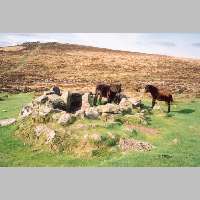

 dr Paul Oliver
dr Paul Oliver
Foundation Stones, The Lessons of Dartmoor
Dartmoor in devon is often regarded as 'the alst great wilderness in southern England' and the rolling landscape, with the hill-crest suddenly interrupted with outcrops of rock known as 'tors', is dramatic. Though it retains its appeal as rough and untamed country, the evidence of a history of occupation and use over more than three thousand years is still there. Extending to some 1000 sq. km (400 square miles), the moor is largely open pasture for sheep, cattle and native ponies, but in the valleys and on the hill slopes there are villages and farms.
Situated on the granite belt, which extends from the Scottish highlands to northern Portugal, Dartmoor's buildings are of this intracable but very durable stone. It splits into blocks caused by the erosion of centuries of exposure. many hundreds of hut and settlement sites dating back to the Bronze Age have been located, some having been excavated while others have been left undisturbed. Particularly fascinating are the ancient stone rows which terminate in menhirs or great stone circles. Later Iron Age sites include iron forges, while ancient field systems indicate the extent of land management at this period.
Climate change in the first millenium AD caused some people to leave the moor, but new settlements were established in the 9th and 10th centuries. Their foundation reveal the emergence of the Dartmoor 'longhouse', a vernacular building type constructed in granite under thatch or slate roofs, with accomodation for both people and animals. Well over a hundred longhouses remain, as do other functional structures such as corn-kilns, barns and stables. Buildings that served stone quarries, tin mines, and mills are also to be found, while the vernacular architecture of the villages includes churches, market crosses, shops, inns and 'pubs'.
Students of International Studies in Vernacular Architecture (MA) may come from all over the world, but they commence the programme with a field trip on Dartmoor. While living in a longhouse on a working farm they research the archeology, the technology, the inheritance and the contemporary relevance of vernacular architecture of the moor, which provides a firm foundation for their subsequent studies on the Master's course and for their professional careers.
Za povečavo kliknite na sliko
Click on picture to enlarge

fig. 1
|

fig. 2
|
slika 1
Grimspound - zaselek iz bronaste dobe v Dartmoor
Divja ponija na enem izmed izkopanih objektov, cca 1500 p.n.š. V ozadju vidni ostanki stolpa - "tor".
fig. 1
Grimspound - a bronze age settlement on Dartmoor
2 wild Dartmoon ponies are standing by one of the excavated hut sites, cca 1500 BC. A "tor" is in the background.
foto: Valerie Oliver
slika 2
Hole farm - "dolga hiša" iz Dartmoor
Zgrajena iz granita. Stanovanjski del kmetije je na desni strani. Prečni hodnik se zaključi z verando. Podolgovati del na levi strani je hlev za drobnico, imenovan "shippon".
fig. 2
Hole farm - a Dartmoor longhouse
Built in granite. The "livier" for the farmer's family is to the right. The cross passage has the porch. The long structure at the left was the cattle shed, called a "shippon".
foto: Valerie Oliver


 dr Paul Oliver
dr Paul Oliver

